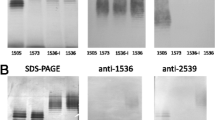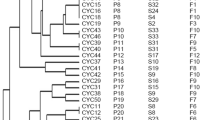Abstract
Hippurate hydrolysis tests performed on the serotype reference strains of the serotyping scheme based on thermostable antigens under development forCampylobacter jejuni showed that 42 strains wereCampylobacter jejuni and 17 wereCampylobacter coli. Moreover, only four (0.2 %) of 2025 hippurate positiveCampylobacter jejuni isolates reacted inCampylobacter coli antisera and 12 (4.3 %) of the 282Campylobacter coli reacted inCampylobacter jejuni antisera. Evidently each species has its own array of antigenic specificities. Separate schemes for serotypingCampylobacter jejuni andCampylobacter coli are advocated.
Similar content being viewed by others
References
Penner, J. L., Hennessy, J. N.: Passive hemagglutination technique for serotypingCampylobacter fetus subsp.jejuni on the basis of soluble heatstable antigens. Journal of Clinical Microbiology 1980, 12: 732–737.
Lauwers, S., Vlaes, L., Butzler, J. P.:Campylobacter serotyping and epidemiology. Lancet 1981, i: 158–159.
Harvey, S. M.: Hippurate hydrolysis byCampylobacter fetus. Journal of Clinical Microbiology 1980, 11: 435–437.
Hwang, M.-N., Ederer, G. M.: Rapid hippurate hydrolysis method for presumptive identification of Group B streptococci. Journal of Clinical Microbiology 1975, 1: 114–115.
Berg, R. L., Jutila, J. W., Firehammer, B. D.: A revised classification ofVibrio fetus. American Journal of Veterinary Research 1971, 32: 11–22.
Leive, L., Shovlin, V. K., Mergenhagen, S. E.: Physical, chemical, and immunological properties of lipopolysaccharides released fromEscherichia coli by ethylenediamineterteraacetate. Journal of Biological Chemistry 1968, 243: 6384–6391.
Naess, V., Hofstad, T.: Isolation and chemical composition of lipopolysaccharide fromCampylobacter jejuni. Acta Pathologica, Microbiologica et Immunologica Scandinavica (B) 1982, 90: 135–139.
Karmali, M. A., Penner, J. L., Fleming, P. C., Williams, A., Hennessy, J. N.: The serotype and biotype distribution of clinical isolates ofCampylobacter jejuni-coli over a three year period. Journal of Infectious Diseases 1983, 147: 243–246.
McMyne, P. M. S., Penner, J. L., Mathias, R. G., Black, W. A., Hennessy, J. N.: Serotyping ofCampylobacter jejuni isolates from sporadic cases and outbreaks in British Columbia. Journal of Clinical Microbiology 1982, 16: 281–285.
Bradbury, W. C., Marko, M. A., Hennessy, J. N., Penner, J. L.: The occurrence of plasmid DNA in serologically defined strains ofCampylobacter jejuni andCampylobacter coli. Infection and Immunity 1983, 40: 460–463.
Ahnen, P. J., Brown, W. R.:Campylobacter enteritis in immune-deficient patients. Annals of Internal Medicine 1982, 96: 187.
Karmali, M. A., Kosoy, M., Newman, A., Tischler, M., Penner, J. L.: Reinfection withCampylobacter jejuni. Lancet 1981, ii: 1104.
Blaser, M. J., Penner, J. L., Wells, J. G.: Diversity of serotypes in outbreaks of enteritis due toCampylobacter jejuni. Journal of Infectious Diseases 1982, 146: 826.
Author information
Authors and Affiliations
Rights and permissions
About this article
Cite this article
Penner, J.L., Hennessy, J.N. & Congi, R.V. Serotyping ofCampylobacter jejuni andCampylobacter coli on the basis of thermostable antigens. Eur. J, Clin. Microbiol. 2, 378–383 (1983). https://doi.org/10.1007/BF02019474
Issue Date:
DOI: https://doi.org/10.1007/BF02019474




